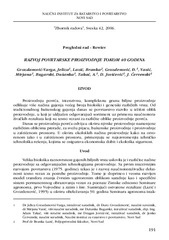Приказ основних података о документу
Development of vegetable production over the last 40 years
Razvoj povrtarske proizvodnje tokom 40 godina
| dc.creator | Gvozdanović-Varga, Jelica | |
| dc.creator | Lazić, Branka | |
| dc.creator | Gvozdenović, Đuro | |
| dc.creator | Vasić, Mirjana | |
| dc.creator | Bugarski, Dušanka | |
| dc.creator | Takač, Adam | |
| dc.creator | Jovićević, Dragan | |
| dc.creator | Červenski, Janko | |
| dc.date.accessioned | 2021-04-26T18:10:48Z | |
| dc.date.available | 2021-04-26T18:10:48Z | |
| dc.date.issued | 2006 | |
| dc.identifier.issn | 0354-7698 | |
| dc.identifier.uri | http://fiver.ifvcns.rs/handle/123456789/388 | |
| dc.description.abstract | As a result of the great biological diversity of the cultivated vegetable crop species, there are many different methods of vegetable production, each with its own accompanying growing technology. The intensive development of vegetable growing that began in 1975 triggered a parallel development of research closely tied with the needs of vegetable production. Today vegetable production takes the forms of year-round field production intended for various types of processing, field production intended for the fresh market, intensive garden production, and indoor vegetable production. Research conducted as part of developing environmentally-friendly ways of field vegetable production has resulted in the development of methods for the mechanized covering of soil with black biodegradable foil, while early vegetable production is carried out by covering the plants with materials known as agrotextiles, in which case the best results are achieved by combining mulching and direct covering of plants. Indoor vegetable production has gone through the largest amount of technical and technological change and is a form of industrial vegetable production on different substrates using controlled and programmed mineral nutrition as well as microclimate regulation using different materials for light and temperature regulation. The importance of vegetables comes not only from their role as food and medicine (as a medicinal supplement and part of folk medicine) but also from their aesthetic value, as today they are part of horticultural management of gardens and green spaces. For each of the above methods of growing, an adequate cultivar range was tested and the quality of the end product and its nutritive value were monitored. Growing of a larger number of vegetable crop species and the use of secondary products of crop growing has led to the development of environmentally-friendly growing methods, which are part of sustainable development. The transition from conventional to sustainable production leads through production based on principles of good agricultural practice (GAP). All research results are important for the development of different production technologies. Today, they are the most important segments of modern technologies, including the GIS system of precision satellite-guided production, which, along with the use of the latest technical solutions, must guarantee economic gain and environmental safety. | en |
| dc.description.abstract | Proizvodnju povrća, intenzivnu, kompleksnu granu biljne proizvodnje odlikuje više načina gajenja većeg broja biološki i genetski različitih vrsta. Od tradicionalnog baštenskog gajenja danas se povrtarstvo razvilo u tržišni oblik proizvodnje, u koji je uključen odgovarajući sortiment uz primenu naučnoistra- živačkih rezultata koji su tesno vezani za različite oblike proizvodnje povrća. Danas se proizvodnja povrća odvija u okviru njivske proizvodnje namenjene različitim oblicima prerade, za svežu pijacu, baštenske proizvodnje i proizvodnje u zaštićenom prostoru. U okviru ekoloških načina proizvodnje kako na otvorenom tako i u zaštićenom prostoru, primenjuju se najsavremenjia tehničko tehnološka rešenja, kojima se osigurava ekonomska dobit i ekološka sigurnost. | sr |
| dc.publisher | Institut za ratarstvo i povrtarstvo, Novi Sad | |
| dc.rights | openAccess | |
| dc.source | Zbornik radova Instituta za ratarstvo i povrtarstvo | |
| dc.subject | vegetables | en |
| dc.subject | growing | en |
| dc.subject | modernization | en |
| dc.title | Development of vegetable production over the last 40 years | en |
| dc.title | Razvoj povrtarske proizvodnje tokom 40 godina | sr |
| dc.type | article | |
| dc.rights.license | ARR | |
| dc.citation.epage | 206 | |
| dc.citation.issue | 1 | |
| dc.citation.other | 42(1): 191-206 | |
| dc.citation.spage | 191 | |
| dc.citation.volume | 42 | |
| dc.identifier.fulltext | http://fiver.ifvcns.rs/bitstream/id/1239/385.pdf | |
| dc.identifier.rcub | https://hdl.handle.net/21.15107/rcub_fiver_388 | |
| dc.type.version | publishedVersion |


